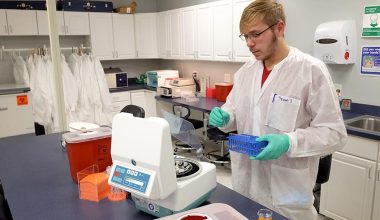Horticulture and agriculture deals with the cultivation of plants. However, its differences and similarities continue to confuse people that wish to go into the field.
This article will explain the definition of horticulture vs agriculture degrees. You will also know their job description, schools where you can study them, and cost, salary, and job growth.
Horticulture is a branch of plant agriculture. Both fields of study deal with the cultivation of crops for the benefit of mankind.
With this, you can have a little understanding of the relationship. As we proceed further, you will see more similarities and differences between the two fields.
Meanwhile, you can see the highlights of this post in the table of contents below.
Table of contents
- What is Horticulture?
- What is Agriculture?
- Horticulture vs Agriculture: How do I know the similarities?
- What are the differences between Horticulture and Agriculture?
- Horticulture vs Agriculture: Educational requirements for a degree
- What are the best schools for studying Horticulture and Agriculture?
- How much will it cost me to study Horticulture or Agriculture?
- Job description of Horticulturists and Agriculturists
- What is the salary and job outlook of Horticulturists and Agriculturists?
- FAQs on Horticulture Degree vs Agriculture Degree
- References
- Recommendations
What is Horticulture?
Horticulture is the science and art of cultivating, propagating, processing, and marketing of ornamental plants, flowers, turf, vegetables, fruits, and nuts. In addition, it involves the management and cultivation of gardens and land.
The different types of horticultural crops include annual and perennial species, delicious fruits and vegetables, and decorative indoor and landscape plants. These horticultural crops sustain and enrich our lives by giving us nutritious food, giving more beauty to our homes and communities. They also help to reduce our carbon footprint.
Horticulture as a field of study has so many branches including:
- Arboriculture: The study of, and the selection, plant, care, and removal of, individual trees, shrubs, vines, and other perennial woody plants.
- Turf management: This deals with the production and maintenance of turfgrass for sports, leisure use, or amenity use.
- Floriculture: It involves the production and marketing of floral crops and the study of flower cultivation.
- Landscape horticulture: It deals with the production, marketing, and maintenance of landscape plants.
- Olericulture: This deals with the production and selling of vegetables.
- Pomology: This is the study of how to produce and market fruits.
- Viticulture: It involves the production and marketing of grapes.
- Oenology: This deals with all aspects of wine and winemaking.
- Postharvest physiology: This is the study of how to maintain the quality and prevent the spoilage of plants and animals.
A person who studies horticulture is called a horticulturist. Horticulturists carry out research in plant breeding, propagation, physiology, and biochemistry. They also research gardening and landscaping, crop production, and genetic engineering.
What is Agriculture?
Agriculture is the science and art of cultivation of crops, rearing of animals for the benefit of man. When you practice agriculture, it is known as “farming”. Scientists, inventors, and others committed to improving farming methods and implements are also said to be practicing agriculture.
Agriculture is divided into two types. They include:
- Subsistence Agriculture
- Industrialized/Commercial Agriculture
Subsistence Agriculture
In subsistence agriculture, the farmer lives on a small piece of land and produces enough food to feed their family and have a small cash crop. The sole aim of subsistence agriculture is to produce enough food for the family. When the production is in excess, the farmer can now sell to other families or individuals.
Farmers practicing subsistence agriculture do not depend on chemical fertilizers, pesticides, and machines. Instead, they use labor force and more natural manure from animals to fertilize the plants.
Industrialized/Commercial Agriculture
Commercial agriculture involves the production of many crops and livestock through mechanized means for sale. The aim of commercial agriculture is to increase crop yield that will feed the masses and for sale.
Farmers practicing commercial agriculture produce large quantities of food because of their farming methods. In other words, they use large machines to work in the fields instead of using animals and labour.
There is always an increase in crop production because of the use of chemical fertilizers and pesticides. The chemical fertilizers always add inorganic nutrients to the soil to improve the plant’s growth and yield. Pesticides used in industrialized agriculture helps to kill pests that are destroying the crops.
Check out and apply: Agriculture Scholarships Around the World 2024 | UPDATED
Horticulture vs Agriculture: How do I know the similarities?
The similarity between horticulture and agriculture is so clear. Horticulture is a branch of agriculture. Both horticulture and agriculture deal with the cultivation and marketing of crops. In addition, they use the same techniques.
What are the differences between Horticulture and Agriculture?
While horticulture is an offshoot of agriculture, there are so many differences between the two practices.
In the table below, we will look at the differences between horticulture and agriculture.
| Agriculture | Horticulture |
| It deals with the cultivation of crops and animals | It deals with the cultivation of crops only |
| The aim of agriculture is only for food consumption | The sole aim of horticulture is for consumption and ornamental purposes. The ornamental group includes arboriculture, floriculture, and landscaping while the edible group includes olericulture, phonology, and viticulture |
| Agricultural practices are carried out on a large scale | Horticultural practices are carried out on a small scale and mostly in the garden |
| The practice of agriculture weakens ecological succession and reduces biodiversity due to mono-cropping which is at the primary stage of succession | Horticulture encourages development of biodiversity and helps to improve ecological succession |
| The cultivation of perennial crops is common in agriculture | The cultivation of annual crops is common in horticulture |
| Artificial or chemical herbicides or pesticides are used in agriculture to control pests and weed | Cultural methods of weed and pest control are used in horticulture |
Read: 15 Best Agriculture Schools in The World | 2024
Horticulture vs Agriculture: Educational requirements for a degree
Both a degree in horticulture and a degree in agriculture share similar educational requirements.
For you to enter the agricultural science and horticultural field, you will need to complete a bachelor’s degree program in a related subject.
Students in these fields will offer introductory courses in botany, chemistry, and soil science. Some courses will require students to take part in laboratory experiments to gain insights into plant cultivation and animal breeding. During the program, students will have to choose a specialization such as horticulture or animal science.
Based on their selection, they take and complete core courses that may include animal husbandry, agroecology, or crop management. Here, they use microscopes and other instruments to monitor and analyze plant specimens or fertilizers.
On the other hand, those who wish to go into research work for academic institutions or firms may need an advanced degree such as a master’s degree or Ph.D. in a field of agriculture.
A master’s degree program in the field will take you between 1 to 2 years to complete. Whereas, a Ph.D. program will require between 3 to 4 years of study and research to complete.
At the graduate level, students gain advanced experience in a particular specialization in the field. For instance, students specializing in animal science may complete advanced courses in genetics and carry out research on an animal’s offspring.
What are the best schools for studying Horticulture and Agriculture?
Pursuing a career in agriculture and choosing to specialize in horticulture is worth it, especially when you study in a top school that offers quality education in the field.
So, we have for you here the best agriculture schools in the world. These institutions offer bachelor’s, master’s, and Ph.D. degree programs in agriculture.
The selection was done based on acceptance rate, number of programs, graduation rate, accreditation, student-faculty ratio, testimonials, and tuition fee.
Therefore, the best schools for agriculture in the world include:
- Wageningen University and Research Center
- Texas A&M
- University of California-Davis
- Cornell University
- University of Michigan
- University of Cambridge
- Utrecht University
- University of Melbourne
- University of Sydney
- Purdue University
- University of Copenhagen
- University of Edinburgh
- ETH Zürich
- University of Florida
- The University of Illinois at Urbana-Champaign
Read: How Can I Get An Online Agriculture Degree In 2024? Schools, Cost, Certifications
How much will it cost me to study Horticulture or Agriculture?
The cost of acquiring a degree in agriculture or specializing in horticulture is the same as most programs. However, the cost of a degree in the field varies from one institution and country to another.
For example, you can expect to pay not more than $41,952 for a four-year degree program in agricultural science in the U.S.A.
Job description of Horticulturists and Agriculturists
A horticulturist’s basic job involves cultivating, marketing, and propagating ornamental plants. They work with different plants, crops, and gardens on so many levels. Just a handful of these farmers work in fields, nurseries. The level of work which they do depends on their education and experience.
Horticulturists help to improve the quality of foods by devising plant retention power, growth, and nutrition. They also carry out nursery or greenhouse management.
Some cultivate plants while others work in laboratories and assist in classrooms in the capacity of a consultant. Those who work in the laboratories analyze plants to find out whether they lack nutrients or have any disease infections. Afterward, they determine the best measures they will use to solve the problems.
An agriculturist;
- Harvests and inspects crops
- Irrigates the farmland and maintains ditches or pipes and pumps
- Operates and repairs farm machinery and tools
- Applies fertilizer or pesticide solutions to control insects, fungi, and weeds
- Feeds livestock, cleans, and disinfects their pens, cages, yards, and hutches
- Examines animals to figure out symptoms of illnesses or injuries and administers vaccines to protect animals from diseases
- Uses brands, tags, or tattoos to mark livestock to show ownership and grade
- Herds livestock to pastures for grazing or to scales, trucks, or other enclosures
What is the salary and job outlook of Horticulturists and Agriculturists?
According to the 2018 U.S Bureau of Labor Statistics report, plant and soil scientists earned an average salary of $70,630 per year; animal scientists made an average of $67,690 per year, and food scientists and technologists earned an average of $72,570 per year. Horticulturists and agriculturists involved in research and development were among the top employers for all three professions.
The job of agricultural and food scientists is projected to grow by 7% between 2018 to 2028. The growth will occur because of the need to balance environmental protection with the demands for agricultural resources, and the development of plant-based biofuels.
Read also: Best Online Agriculture Degree In The World | 2024
Conclusion
Horticulture and agriculture play a major role for the benefit of man. Although horticulture is a branch of agriculture, it differs actually from it. However, you can easily relate to them because some techniques are used interchangeably in both careers. Horticulture is a complete science of its own and a full industry.
Although both careers share a common goal, they have many differences, which you can see from this article.
FAQs on Horticulture Degree vs Agriculture Degree
Below are the branches of horticulture:
1. Arboriculture: Study of, and the selection, planting, care, and removal of, individual trees, shrubs, vines, and other perennial woody plants.
2. Floriculture: Production and marketing of floral crops.
3. Landscape horticulture: Production, marketing, and maintenance of landscape plants.
4. Olericulture: Includes the production and marketing of vegetables.
5. Pomology: Production and marketing of fruits.
6. Viticulture: Production and marketing of grapes.
7. Oenology: All aspects of wine and winemaking.
8. Postharvest: Maintaining the quality of and preventing the spoilage of horticultural crops.
To become a horticulturist, you will need to possess:
1. A passion for plants and the environment
2. Attention to detail
3. A sense of creativity
4. Problem-solving and critical thinking skills
5. Excellent communication skills
6. Persuasion skills
The top-paying jobs in the field of Agriculture include:
1. Agricultural Lawyer – $115,820 per year
2. Agricultural Economist – $104,920 per year
3. Biochemist – $91,190 per year
4. Environmental Engineer – $86,800 per year
5. Bioinformatics Scientist – $80,200 per year
6. Agronomy Sales Manager – $76,470 per year
7. Agricultural Engineer – $74,480 per year
8. Food Scientist – $71,990 per year
9. Animal Geneticist – $68,840 per year
10. Agricultural Operations Manager – $61,080 per year
References
- Agriculture
- Meaning of Horticulture and Its Various Sub-Fields
- What is the difference between horticulture and agriculture
Recommendations
- $100,000 GCHERA World Agriculture Prize
- Best Accredited Agriculture Schools in California | 2024
- TOP 15 AGRICULTURE SCHOLARSHIPS 2024 [UPDATED]
- What is DBT Agriculture? Benefits, Schemes and Portal 2024
Does this article meet your immediate needs? If yes, please kindly share it with your friends. If no, drop your question and/ or your opinion in the comment section below.
DISCLOSURE: This post may contain affiliate links, meaning when you click the links and make a purchase, we receive a commission.






1 comment
Comments are closed.